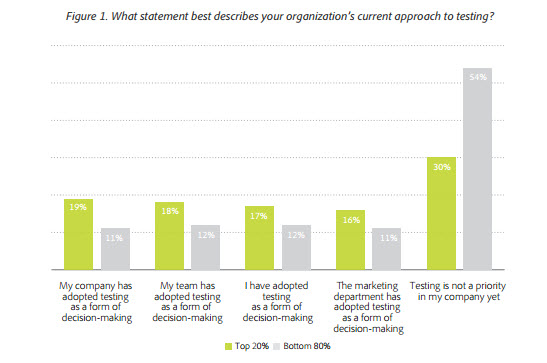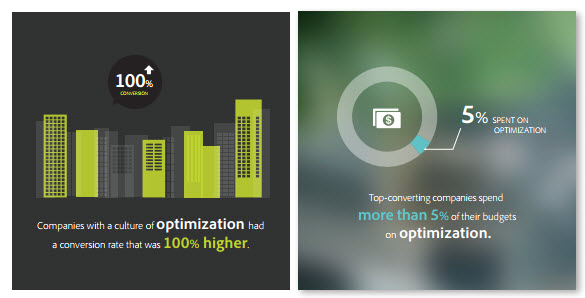How to Not Make an Ass Out of Yourself: Building a Data-Driven Culture
 Back when I was in journalism school, one of my professors gave me a valuable piece of advice.
Back when I was in journalism school, one of my professors gave me a valuable piece of advice.
“When you assume, you make an ass out of u and me.”
It sounds silly, but the world of online marketing would do well to follow that advice a little closer. Like a lot of folks, I made the jump from journalism to digital marketing once I got a serious taste of just how bad newspapers are right now.
When I made that transition, I was really struck by the sheer amount of careless assumption that gets thrown around in this business.
We live in an era of unparalleled data access — a world where Target can figure out that you’re pregnant before you do — and yet, there’s a number of marketers out there who are still using the Medieval alchemist’s “let’s throw chemicals into a bowl and see if it makes a duck” method. It’s madness, and as a survey from Adobe points out, it’s a huge waste of money.
Adobe’s survey asked 1,000 marketers to detail how much attention they pay to data analytics and to share their conversion rates. Respondents in the 80th percentile or greater reported conversion rates of 9 percent and above. They also reported a vastly higher level of attention to data than other marketers.
The bottom 35 percent checked in with conversion rates between .5 and 1.9 percent.
Simply put: paying attention to your data can quadruple sales or leads from your existing traffic. It’s not even talking about an extra investment in building traffic or advertising; if you just pay attention to what your customers want, you’ll do better at this.
What’s the common thread?
Marketers with stellar conversion rates don’t base decisions off of assumptions. They pay attention to data, and they do it well.
Once you’re using data to make decisions, you are now testing.
In the study, 70 percent of top performers said they used testing in various capacities. The low performers did not.
How you test is a matter if your business’s individual needs. After all, the point of this post is to emphasize that there are no real “rules of thumb,” and that you should be looking at empirical data to determine your priorities.
How to build a culture
Instead, Adobe’s survey found that businesses should build a culture toward data-driven strategy, and it’s something I agree with wholeheartedly. It’s not simply the responsibility of the ecommerce department or the SEO person to look at the numbers. It’s everyone’s responsibility.
Respondents in the top 20 percent were 88 percent more likely to use other departments in testing efforts.
How can you develop a culture like this?
- Base your decision making on quantitative data That means taking and interpreting data for what it is, not allowing biases or reporting methods to skew what you are collecting. Your data should be clean, consistent and trustworthy.
- Once you have a solid quantitative understanding of your business’s strengths and weakness, you can begin qualitative research. Build a road map off of what you know. If a page isn’t converting as it should or if your mobile traffic is crap, use existing data to develop a hypothesis as to why, test it to the point of having a statistically valid result, and then make changes based off that.
- Don’t be afraid to fail. Many of the bottom-ranked marketers in Adobe’s survey did pay attention to testing, but were making hasty decisions on tests or weren’t interpreting data correctly. It’s better to wait and have statistical validation that your test failed than it is to implement a bad test, and then have to go back and fix your mistake.
- Include stakeholders in other departments in your analytics and conversion testing. Create top-level summaries of what you’re doing and the potential ROI that could be generated. Use this to develop involvement.
- Keep them in the loop with consistent reporting. Even using a rudimentary analysis of data, you’ll quickly be able to grow an understanding of your customers’ behavior. By keeping everyone informed, you’ll spur cross-departmental growth. For an online store, information from the ecommerce department can help the merchandising department make smarter decisions with stocking product.
As the data shows, organizations that simply work toward a culture of data analysis and optimization already have a leg up on the competition.
It seems easy enough, but I know it can be hard to change a culture. For those reading this, I’d like to know about the cultures you’ve worked with. What’s the worst assumption you’ve seen a marketer make in practice?
Justin Coons
Recent Posts
Recent Comments
- Shannon Thammasiene on How to Create a Successful Blog
- Sarah on How to Create a Successful Blog
- How to Create a Successful Blog on 5 Free Keyword Research Tools that will Rock your Socks
- Olivier Hamphrey on This Week In Social Media
- Richard Dickerson on Use Email to Sell without Selling





